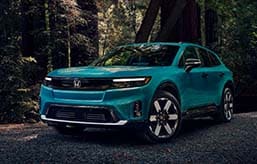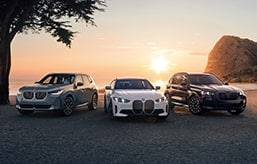- The new sixth-generation 4Runner has arrived, with a new Trailhunter trim.
- We set out to find out if the 4Runner Trailhunter has what it takes to best the Jeep Wrangler and Ford Bronco off-road.
- Jeep and Toyota both offer hybrid powertrains; will that give them an advantage?
2025 Toyota 4Runner vs. Ford Bronco vs. Jeep Wrangler: The Off-Road Showdown
Can Toyota's new off-roader keep up with its American competition?
It was a long, long, 16-year wait, but the new sixth-generation Toyota 4Runner is finally here. Joining the lineup this time around is a new Trailhunter trim level designed to give the 4Runner even better rock-crawling, overlanding chops. That makes it an even better foe for segment stalwarts, the Ford Bronco and Jeep Wrangler. How do these SUVs stack up when the going gets tough? That's what we're here to find out.
Toyota 4Runner vs. Jeep Wrangler vs. Ford Bronco
Spec | Toyota 4Runner Trailhunter | Jeep Wrangler Rubicon 4xe | Ford Bronco Badlands Sasquatch |
|---|---|---|---|
Engine | turbo 2.0-liter I4 | turbo 2.0-liter I4 | turbo 2.7-liter V6 |
Electric motors | 2 | 2 | N/A |
Power | 323 hp | 375 hp | 315 hp |
Torque | 465 lb-ft | 470 lb-ft | 410 hp |
Transmission | 8-speed automatic | 8-speed automatic | 10-speed automatic |
Approach angle | 33 degrees | 43.8 degrees | 43.3 degrees |
Breakover angle | 24 degrees | 22.5 degrees | 26.3 degrees |
Departure angle | 24 degrees | 35.6 degrees | 36.9 degrees |
Ground clearance | 10.1 inches | 10.8 inches | 11.5 inches |
As-tested price | $68,350 | $78,995 | $69,985 |
Test 1: Hill climb
We elected to use a short portion of our traditional hill climb out in Johnson Valley, California, which presents a stiff challenge with its loose surface that's studded with rocks. This would prove to be a challenge for these SUVs' traction control systems. We started each vehicle off in high-range four-wheel drive with the most basic off-road mode turned on, then we layered in more equipment as needed (and without tearing up the trail too much).
In the 4Runner, once it reached the first step up on the rocks, it got stuck and we had to lock the rear axle. Once we did that, the 4Runner made it up the rest of the hill without much of a problem. It was perfectly easy to dial in as much power as we needed from the hybrid engine, and Toyota's traction control system was great here, too, never cutting in unnecessarily.
We attempted to scale the same hill in the Wrangler solely using its electric motor, but it didn't have enough juice to pull the SUV up on the rocky section. So we kicked the Jeep over into its hybrid drive mode and that smoothed out the inputs a bit. Same as the 4Runner, we started in high range but had to select a partial low range that mandated locking both the front and rear axles even though that was likely overkill.
The Bronco was even simpler; it too got stuck at the same spot as the other SUVs while in high-range four-wheel drive and its default off-road drive mode, but to get up the rocks we simply had to turn off the traction control and put it in its Mud/Ruts drive mode. Power output from the turbocharged V6 was easy to modulate here too.
Test 2: Makeshift ziggurat
This is the realm of the Wrangler, with its disconnecting front and rear stabilizer bars and dual live axles. And it didn't disappoint, climbing about 3 feet farther up the rock we use as a stand-in for a stepped ziggurat than the Bronco and the 4Runner. The Bronco beat the 4Runner, but we were impressed with the amount of articulation shown by the Toyota. It's significantly more flexible than its predecessor.
A quick note on underbody protection: The skid plates on the Wrangler and Bronco cover a lot more than the 4Runner, which mostly uses steel (or composite for the fuel tank) wrapped around individual parts instead of the larger plates you'll find on the other two SUVs. If you want greater underbody protection for your Toyota, you'll have to turn to the aftermarket.
(Update: A Toyota spokesperson confirmed that the 4Runner we tested was missing the stronger skid plates that come standard on the Trailhunter. "The were some skid plates on there but not the beefed up ones that come with the Trailhunter package," they said. "This is due to the 4Runner being an early prototype." We look forward to retesting a 4Runner Trailhunter with the production skid plates installed.)
Test 3: Rock crawl
In the 4Runner, with its worse approach and departure angles, we had to be a lot more careful with how we tackled this obstacle. Thankfully, while in low-range four-wheel drive, the hybrid powertrain's output was incredibly smooth and it was easy to dial in the exact amount of oomph needed to get up on the next rock. And the Toyota's various camera views prominently displayed on its 14-inch screen also made life a little easier, as we could also see our spotter when pitched up. We had to take a different route to get on the rocks than in the other two vehicles, which simply climbed straight onto the course. But the 4Runner made it through with minimal scraping.
The Wrangler's forward visibility was superior to that of the other two vehicles, but its camera system was not in the same league. You get a forward-facing camera but it's lower-resolution and doesn't have guidelines to see where the front tires are. We were surprised at the jumpiness of the powertrain, even in low-range four-wheel drive. Other versions of the Wrangler don't feel this way; we chalked it up to a poor power blend between the electric motor and the gas engine. Still, the Jeep's superior clearances and flexibility made this obstacle a breeze.
Similarly, the Ford's ground clearance and approach angle made easy work of the rock crawl and it kept its skid plates off the rocks even more than the Wrangler. Having the biggest tires also helped the Ford here. Its cameras were fantastic, and that's great because seeing over that big hood proved to be a challenge.
Test 4: Trail ride
The 4Runner's powertrain was great at lower speeds, but it did run out of breath when we really wanted to get going. It was much harder to hang the 4Runner's tail out with the throttle and there was a touch of lagginess when we wanted max power all at once. The Trailhunter also comes with a snorkel to move its intake out of the dust, but it causes lots of wastegate and turbo noises right where the passenger sits, which got annoying after a while. It also made the cabin incredibly loud.
As much as we didn't particularly like the 4xe's performance at lower speeds, while running at higher speed on a trail, it was fantastic. The Wrangler had easy power at all times and the engine revved up quickly to meet the demand when greater throttle application was applied. The Wrangler was the worst of these three to drive on the street, but there's no surprises there. You're trading on-road comfort for maximum off-road capability.
Ford's Trail Turn Assist was a great feature here, dragging the inside rear wheel through turns, so it felt like the SUV cornered on a dime. It also had the best-sounding engine here by far and was the most fun to drive at higher speeds. We'd still give this one the edge on looks too.
The verdict
Of the three, the one we'd drive home is the Bronco. It's better to drive on the street than the Wrangler and better at tackling off-road obstacles than the 4Runner.
The Wrangler's second-place finish comes by virtue of its flexibility and more robust off-road goodies than the other two SUVs.
The 4Runner comes in third, but we wouldn't dare call it a loser; this one might actually make the most sense for shoppers in this segment. The 4Runner can do 90% of what the other two SUVs can do, and it drives well enough on the street that you never feel like you're compromising a great deal of livability to get this kind of capability.









 by
by  edited by
edited by